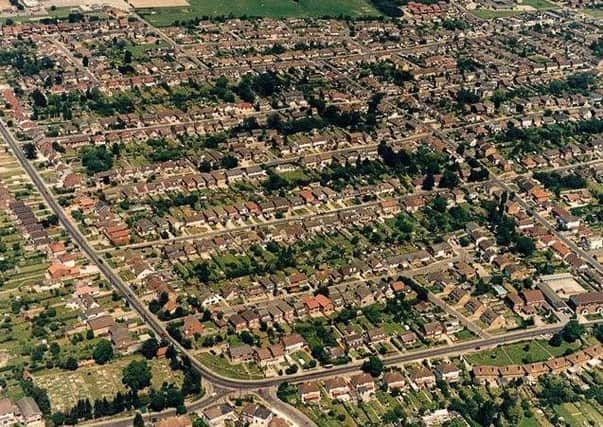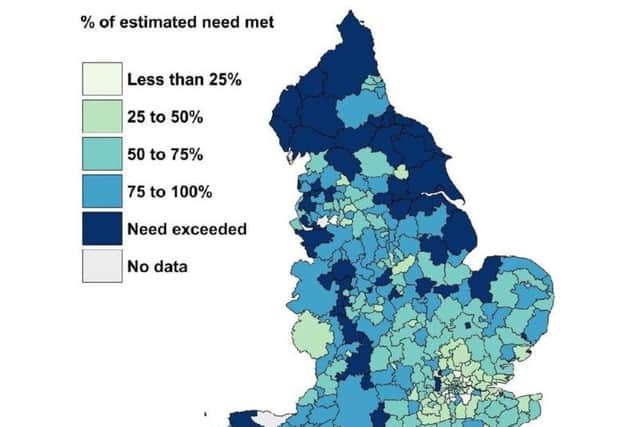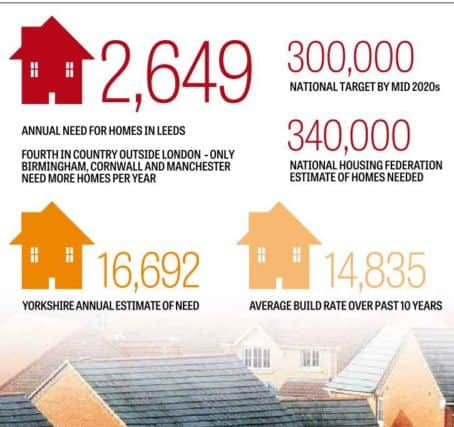Two thirds of Yorkshire areas still not building homes at pre-recession levels


Major new analysis of official Government housing data has also revealed huge discrepancies in housing supply between individual cities and rural districts in the county, and between the numbers of new homes councils and Ministers believe each area needs.
The study was compiled by comparing Government estimates of annual housing need in individual areas with average housing supply rates since the year before the global financial crash.
Advertisement
Hide AdAdvertisement
Hide AdAccording to the figures, York had the lowest percentage build rate in Yorkshire compared to its Government assessment of need.


Across the county, the research showed that although twelve of 21 council areas in Yorkshire are building above their individual Government assessments, the county as a whole is still not building enough homes every year on average to meet long term demand.
There were some exceptions, with Richmondshire in North Yorkshire having the highest percentage of new homes in the whole country, and Scarborough the third highest. The remainder of the top 10 was also made up of northern councils.
However the overall lag in build rates has led to claims that “messy” planning policies and a “fetishisation” of the green belt are hampering the pace of building and thereby slowing the economic growth potential of the region as a whole.
Advertisement
Hide AdAdvertisement
Hide AdAcross the country, detailed analysis of regional variations in house building by the BBC’s Shared Data Unit revealed that a decade after the global economic downturn, less than one in five areas of England are building enough homes every year at a pace to meet the Government’s medium to long-term housing need estimates, and the majority of areas have still not got back to supplying new homes at the same rates they were before the global economic crash of 2008.


The Government today re-affirmed its pledge to enable the building of 300,000 homes a year in England by the mid 2020s.
But campaigners claimed the numbers needed have been underestimated, and called on Ministers to deal with the “national emergency” by putting affordability at the centre of policy.
Shadow Housing Minister and Wentworth and Dearne MP John Healey said: “The housing crisis is getting worse. Over the last eight years, we have seen home ownership levels fall. We have seen homelessness and rents rise. We have seen the level of house building still not back at its pre-global financial crisis peak, and for many people, the housing crisis is a housing costs crisis, a crisis of housing affordability.
Advertisement
Hide AdAdvertisement
Hide Ad“And whilst there are failures at a local level, the main responsibility must lie with Government. When you have government weakening the powers of councils to drive a better bargain with big house builders for people in their area, when you get a Government chopping and changing the planning rules as they have done in five separate acts of Parliament in the last eight years, you get a system which is failing.”
York Central MP Rachael Maskell said a politically-driven reluctance to build on the green belt – and instead focus on “little scraps of brownfield space” and on luxury apartments rather then family homes – were major factors in individual areas’ building successes and failures.
“We need to make sure we build the right kind of homes,” she said.
“We [in York] have a site with 1,000 homes, the British Sugar site, which has just three per cent social housing, when we have got real social housing need.
Advertisement
Hide AdAdvertisement
Hide Ad“Developers are using and abusing the freedoms they have got in order to achieve the profits they want. (We should be) turning it on its head, saying ‘what is the local housing need?’ – which clearly these figures are supposed to show – and then to build on that.”
Ms Maskell added: “Clearly policy isn’t working because there are areas like York which are shamefully behind where they should be.
“But some authorities are turning a blind eye and are more concerned with addressing other agendas than actually saying we have a housing need.
“The way that it is showing itself is that we cannot recruit the skills that we need for our cities – care workers, nurses – because they can’t afford to live here.
“So it’s having a massive impact on services.”
Advertisement
Hide AdAdvertisement
Hide AdMs Maskell also worried about other negative impacts, adding: “Not getting this equation right puts the economy in a negative spiral.
“None of us know what Brexit is going to do to any of that, but we absolutely need to think long-term planning.
“We need policy to be future proofed to make sure we are building for the future.”
The BBC findings were published as the Government also faced renewed calls to abolish stamp duty for pensioners moving house in a move that would free up much-needed family homes for younger buyers.
Advertisement
Hide AdAdvertisement
Hide AdYorkshire peer Lord Best called on chancellor Philip Hammond to follow-up his announcement in last year’s Autumn Budget that first-time buyers would pay no stamp duty on homes costing less than £300,000 with a similar move for over-65s.
Last year, research by the National Housing Federation found that average house prices in Yorkshire are now more than seven times average salaries.
WHAT DOES THE GOVERNMENT SAY?
Ministers today reinforced their commitment to “building a housing market for the future”, insisting that recent build rates overall have actually hit a nine-year high.
In July, the Government published the latest revised version of its NPPF (National Planning Policy Framework) – its planning rulebook – where new Housing and Communities Secretary James Brokenshire pledged to shift the focus onto building the right number of quality new homes in the right locations.
Advertisement
Hide AdAdvertisement
Hide AdThe plan also sets out a new way for councils to calculate the housing need of their local community.
Mr Brokenshire said at the time: “Fundamental to building the homes our country needs is ensuring that our planning system is fit for the future.
“I am clear that quantity must never compromise the quality of what is built, and this is reflected in the new rules.”
Responding to the latest findings on varying regional build rates, a spokesman for the Ministry of Housing, Communities and Local Government said: “This Government is committed to building a housing market fit for the future and 217,000 new homes were delivered in England last year.
Advertisement
Hide AdAdvertisement
Hide Ad“This is up 15 per cent on the previous year and the highest increase in nine years. We have also set out an ambitious programme of reforms to boost housing supply – including planning reform and targeted investment to help us deliver an additional 300,000 properties a year by the mid-2020s.”
Under current policy, the UK Government does not set concrete house-building targets, but rather advises councils to set their own estimates based on their local plans.
However Mr Brokenshire’s predecessor Sajid Javid had earlier threatened to start imposing strict targets on council areas which failed to deliver enough homes.
Wales, Scotland and Northern Ireland set their own housing growth indicators.